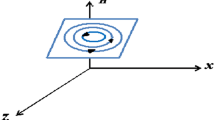Abstract
The existence of the energy-concentration effect in the regions between the inclusions of a high-contrast heavy-charged composite material has been verified in the process of numerical solution of the problem on heat conduction in this material. The formation of a high-energy region (energy “neck”) under different conditions depending on the contrast range of the composite-material components and the distance between the inclusions has been investigated.
Similar content being viewed by others
References
L. V. Berlyand and A. G. Kolpakov, Network approximation in the limit of small interparticle distance of effective properties of a high contrast random dispersed composite, Arch. Rational Mech. Anal., No. 3, 179–227 (2001).
A. G. Kolpakov, Asymptotics of the conducting properties of highly contrast media, Prikl. Mekh. Tekh. Fiz., Issue 3, 128–140 (2005).
J. B. Keller, Conductivity of a medium containing a dense array of ideal conducting bodies or cylinders or nonconducting cylinders, J. Appl. Phys., 34,No. 4, 991–993 (1963).
M. Sahimi, Heterogeneous Materials, Springer, New York (2003).
R. Courant and G. Hilbert, Methods of Mathematical Physics [Russian translation], Gostekhizdat, Moscow (1951).
V. Smythe, Static and Dynamic Electricity [Russian translation], IL, Moscow (1954).
S. Kari, H. Berger, and U. Gabbert, Numerical analysis of effective material properties of randomly distributed short cylindrical fiber composites, in: 7 Magdeburger Maschinenbau-Tage, 11–12 October 2005, Tagungsband, Magdeburg. Univ., Magdeburg (2005), pp. 127–134.
I. Babushka, B. Anderson, P. Smith, and K. Levin, Damage analysis of fiber composites. Pt. I. Statistical analysis on fiber scale, Comput. Methods Appl. Mech. Engng., 172, 27–77 (1999).
B. N. Arzamasov, I. I. Sidorin, G. F. Kosolapov, et al., Material Science [in Russian], Mashinostroenie, Moscow (1986).
A. A. Kolpakov and A. G. Kolpakov, Asymptotics of the capacitance of close bodies. The I. E. Tamm screening effect and net models, Dokl. Ross. Akad. Nauk, 414,No. 2, 1–5 (2007).
Author information
Authors and Affiliations
Corresponding author
Additional information
__________
Translated from Inzhenerno-Fizicheskii Zhurnal, Vol. 80, No. 4, pp. 166–172, July–August, 2007.
Rights and permissions
About this article
Cite this article
Kolpakov, A.A. Numerical verification of the existence of the energy-concentration effect in a high-contrast heavy-charged composite material. J Eng Phys Thermophy 80, 812–819 (2007). https://doi.org/10.1007/s10891-007-0109-6
Received:
Revised:
Issue Date:
DOI: https://doi.org/10.1007/s10891-007-0109-6




